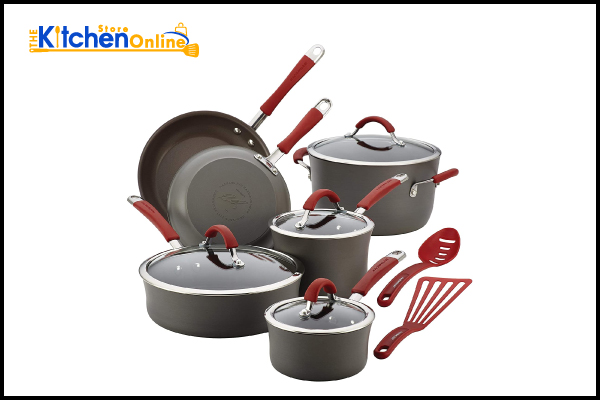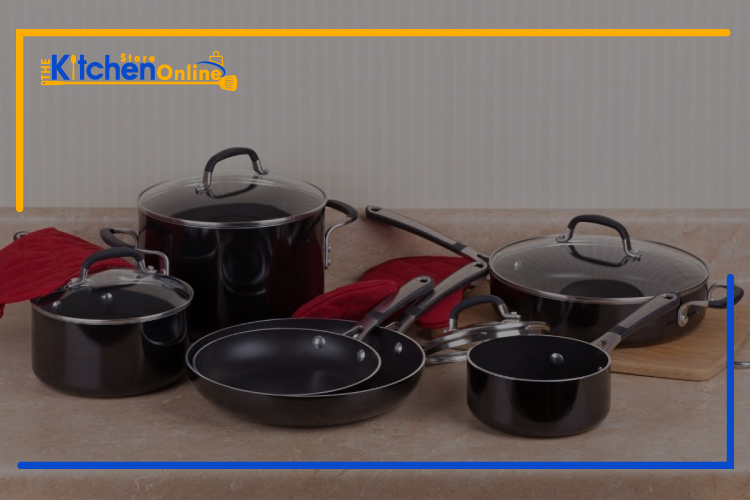Cooking is a very tricky process, and part of that process is picking the right tools. One of the biggest debates in this aspect is whether you should go for hard anodized cookware or stainless-steel ones.
On the one hand, we have cookware produced using newer technology with anodized aluminum, and on the other, we have the age-old stainless-steel ones. Choosing between the two may be overwhelming for you.
But you don’t have to worry about that because we’ve got you covered. In this hard anodized cookware vs. stainless steel debate, we will help you make a sound decision by analyzing the pros and cons of each material and the appropriate use for each of them. So, sit back and enjoy the ride.
What Is Hard Anodized Cookware?
Before we head into the main debate, let’s get to know our contenders a little better. Hard-Anodized cookware refers to all the pots and pans used for cooking that is made of anodized aluminum.
Why aluminum? It is really cheap. Compared to most other metals of great conducting quality and adaptability to heat, it is worth every penny. These features, coupled with the low price, make it the perfect candidate for cooking.
There are a couple of hiccups, however. To start with, it isn’t exactly food safe. Aluminum sheds color. Like a crazy amount. Why is that bad? The color gets on your food, and you end with more of an art project by the time you are done cooking.
On top of that, aluminum isn’t non-stick. This means that your sunny-side side-up will never leave the pan. All that effort will go to waste.
The last problem is its strength. Aluminum is pretty weak, which is one of the reasons it is so cheap. This lack of durability really doesn’t work out well for cooking, unfortunately.
And the solution? All of you familiar with chemistry can where this is heading. The aluminum is anodized to strengthen it, add a non-stick quality, and most importantly, stop the food’s discoloring.
What is anodizing? Anodizing is basically shock therapy for metals. We don’t want to bore you with the technical aspects of the process but simply put, the aluminum has current run through by electrolysis to achieve the perfect material for cookware.
What Is Stainless Steel Cookware?
Stainless steel is another great candidate for a perfect material for cookware. In fact, it is world-famous for serving that role over the years.
Stainless steel, as the name suggests, is a form of steel that is resistant to staining. Ok, we realize how redundant that definition was. To elaborate, it is an alloy of iron that is made to be super easy to maintain.
Was it not detailed enough for you? It’s a mixture of iron, chromium, and other metals such as nickel that is resistant to corrosion. This obviously makes it very popular for its great durability.
Hard Anodized Cookware Vs Stainless steel
Now that we know about both competitors. Let’s finally get to the main event: hard anodized cookware vs. stainless steel, which is the best material for cooking.
Pros of Using Hard Anodized Cookware over Stainless Steel
- The King of Heat
Only copper beats aluminum when it comes to conducting heat. That makes this an easy win for hard anodized cookware. No other pots and pans can beat it when it comes to retaining heat.
This makes it an excellent choice for chefs who love to turn up the heat when cooking and greatly increase their efficiency in the kitchen. To say these pans pack a bit of heat is a massive understatement.
- Non-stick
Another aspect where hard anodized cookware has stainless steel beat is its non-stick properties. It’s not like stainless steel has super glue on it, but it doesn’t hold a candle to the properties of aluminum pots and pans.

- Durable, quick-to-heat, oven-safe cookware set: This cookware boasts…
- Quality, long-lasting nonstick pots, and pans: Pan interiors are coated…
- Set includes 1 quart and 2-quart saucepans with lid, 6-quart stockpot…
- Nonstick, dishwasher-safe cookware: Dishwasher-safe for easy cleaning
The electrolysis does add that perfect texture for cooking and makes it the closest thing possible to non-stick. Obviously, you can’t cook a glue stick on it, but it still resists sticking foods better than most other materials.
- Durable
Yet another area where hard anodized cookware really has an edge is its durability. Remember how we complained about how weak aluminum is? Well, my my my, how the turntables.
The anodizing really gives aluminum quite the glow-up as it is one of the strongest materials you can pick for cookware in the market. This is highlighted by the fact that this material can go through a lot of wear and tear.
- Price
The last benefit of hard anodized cookware is its price. We already hinted about this when we spoke about how cheap aluminum was, but it’s time to drive it home, this time.
Even after the lengthy and complicated electrolysis method, the price of this cookware is way below that of other materials because of how cheap aluminum is. This pack has more than a bang for its buck. Wouldn’t you say?
Cons of Using Hard Anodized Cookware over Stainless Steel
- Still a Little Risky
The fact that it’s been anodized doesn’t make its safety issues disappear completely. This is a huge downside and turns a lot of people away from hard-anodized cookware. Why is that bad?
The main layer of protection between aluminum and your food is the non-stick coating. Despite its impressive durability in general, the non-stick coating tends to wear off after years of usage. Acidic foods can also harm this. This makes it a bit of a safety concern.
- High-maintenance
If the lack of safety hasn’t turned you away yet, the maintenance may do just that. This requires quite a bit of care and needs you to follow specific instructions to make sure you don’t ruin the cookware.
These instructions include not putting it in the oven at high temperatures to protect the non-stick coating, not using induction stoves, and not putting it anywhere near a dishwasher; you need to wash it by hand. So, it does come at a price in terms of the effort you have to put in.
Pros of Using Stainless Steel Cookware over Hard Anodized Cookware
- Easy to Maintain
In sharp contrast, stainless steel is incredibly low maintenance. It literally has zero instructions to follow; well, maybe one. Do not use steel utensils on these pots and pans. That is a sin.
Other than that, this is super easy to use. It is dishwasher safe, meaning you don’t need to scrub it all your life. You can put it in the oven at any temperature. You can even use it on induction stoves. This is a pretty great con in our books.
- Stunning Looks
This is another awesome perk in our books. Stainless steel looks sleek and classy. There’s nothing that looks cooler than the shiny and simple stainless pots and pans that elevate the look of any kitchen.

- A polished cooking surface does not discolor, react with food or alter…
- Cookware also features cool grip handles secured with stainless steel…
- Oven safe up to 550F, Rims are tapered for drip-free pouring.
- Dishwasher safe, Tight-fitting stainless steel covers seal in foods…
We don’t mean to say hard anodized cookware is ugly, but it doesn’t even come close to stainless steel in this aspect; if hard anodized cookware was Brad Pitt, then stainless steel is Danny DeVito. Not even close.
- Super-safe
Another place where we rate stainless steel high is its safety. There are virtually no safety concerns with stainless steel. It is the perfect cookware for those of you who are super concerned with food safety, just like us.
It doesn’t discolor food at all. In fact, it doesn’t react with the food in any way. For this reason, it’s a favorite for home chefs as you can feel at ease when cooking knowing that you aren’t eating metal at the end of the day.
- Decent Durability and Heat
Although it is nowhere close to hard anodized cookware, stainless steel’s durability and heat conductivity are still quite impressive. Nothing to boast about, but it more than gets the job done, especially for home chefs.
Cons of Using Stainless Steel Cookware Over Hard Anodized Cookware
- Expensive
Perhaps the biggest downfall of stainless steel is its super high cost. The cost of these pots and pans overshadows those of its competitors quite a bit due to the pros we just mentioned and the expensive method of making alloys.
- Sticky
Lastly, you miss the non-stick coating present in the hard anodized cookware as the stickiness, although less than other materials, is a little annoying.
Conclusion
There you have it; a short guide on picking the right type of utensils for your cooking needs. As we said in the beginning, it is difficult to pick one as the irrefutable. Otherwise, we wouldn’t be writing an entire article on it.
Each material shines in one aspect but is a little dull in the other. They are both great complements; we suggest mixing and matching these materials and buying utensils made of both of them for different purposes.
At the end of the day, there is no winner in hard anodized cookware vs. stainless steel. You just need to understand which material meets your specific needs. We hope you found this article interesting and easy to follow.





